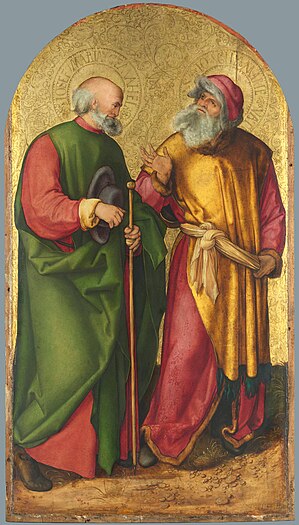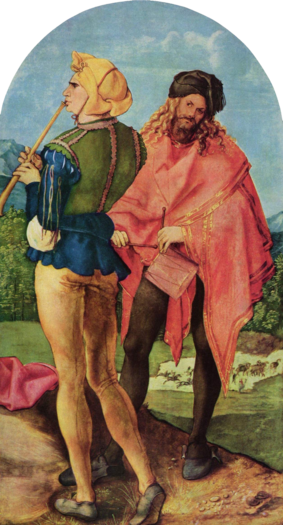Jabach Altarpiece
| Jabach Altarpiece | |
|---|---|
 | |
| Artist | Albrecht Dürer |
| Year | c. 1503–1504 |
| Medium | Oil on panel |
| Location | Alte Pinakothek, Munich Städel, Frankfurt Wallraf-Richartz Museum, Cologne |
The Jabach Altarpiece comprises two pairs of oil on lime tree panel paintings by German Renaissance artist Albrecht Dürer, executed around 1503–1504. Originally a triptych, the central panels are lost. Only the outer and inner side panels are now preserved: the left picture with Job and His Wife, measuring 96 × 51.5 cm, is housed in the Städel of Frankfurt; the picture of the Piper and a Drummer on the right, measuring 94 x 57 cm, is housed in the Wallraf-Richartz Museum of Cologne. These two certain paintings of the Jabach Altarpiece form a single image on the external shutters once closed. The two share a common background, and the dress of Job's wife continues to the right panel as well.[1]
The two pairs of Apostles on gilded background now at the Alte Pinakothek in Munich –Sts. Joseph and Joachim (96 × 54 cm), and Sts. Simon and Lazarus (97 × 55 cm)– have been commonly associated with the polyptych. They are supposedly the panels on the inside of the wings.
History
The altarpiece was probably commissioned by Frederick III, Elector of Saxony, for a chapel in his castle at Wittenberg, perhaps in occasion of the end of the plague in 1503.
The reconstruction of the work is disputed. Some art historians identify the central panel with the Uffizi Adoration of the Magi, while according to others there was instead a group of sculptures.[1]
It is named after one of its owners, Everhard Jabach, in whose family chapel it was still hanging in the late 18th century, before being split up and scattered to different locations.
Description
The left panel depicts the prophet Job seated on a dungheap, with a desperate expression on his face, after Satan has defied him to keep his allegiance to God even in the most tremendous afflictions. These include his flock getting scattered in the other panel, while his properties are on fire at the left edge. Further, his skin is covered by blisters, an appropriate element for a painting likely originated as an ex-voto for the end of plague. His wife, dressed in Renaissance garments, is pouring dirty water above him, while a small devil flees in the far background.[1]
The right panel shows two standing musicians. The right one, with the drum, is perhaps a self-portrait. Their meaning has not been explained: they could be a further element of mockery against Job, or, instead, an attempt to console him through music.[1]
-
 Sts. Joseph and Joachim, Munich, Alte Pinakothek (WAF 228)
Sts. Joseph and Joachim, Munich, Alte Pinakothek (WAF 228) -
 Sts. Simon and Lazarus, Munich (WAF 229)
Sts. Simon and Lazarus, Munich (WAF 229) -
 Job on the Dungheap, Frankfurt, Städel (SM 890)
Job on the Dungheap, Frankfurt, Städel (SM 890) -
 Piper and Drummer, Cologne, Wallraf-Richartz Museum (WRM 0369)
Piper and Drummer, Cologne, Wallraf-Richartz Museum (WRM 0369)
See also
References
- ^ a b c d Costantino Porcu, ed. (2004). Dürer. Milan: Rizzoli.
Sources

- Costantino Porcu, ed. (2004). Dürer. Milan: Rizzoli.
- v
- t
- e
- List of paintings
- Portrait Diptych of Dürer's Parents (1490)
- Portrait of Frederick III of Saxony (1496)
- St. Jerome in the Wilderness (c. 1496)
- Portrait of Dürer's Father at 70 (1497)
- Haller Madonna/Lot and His Daughters (c. 1498)
- Lamentation of Christ (Nuremberg) (attributed, c. 1498)
- Hercules Killing the Stymphalian Birds (1500)
- Lamentation of Christ (Munich) (c. 1500)
- Adoration of the Magi (1504)
- Bagnacavallo Madonna (before 1505)
- Christ Among the Doctors (1506)
- Portrait of a Young Venetian Woman (1505)
- Avarice (1507)
- Adam and Eve (1507)
- Martyrdom of the Ten Thousand (1508)
- The Suicide of Lucretia (1518)
- Virgin and Child with Saint Anne (1519)
- Portrait of Emperor Maximilian I (1519)
- Portrait of Jakob Fugger (c. 1520)
- Portrait of Bernhart von Reesen (1521)
- Saint Jerome in His Study (1521)
- The Four Apostles (1526)
- Portrait of Hieronymus Holzschuher (1526)
- Portrait of Johann Kleberger (1526)
- Portrait of Jakob Muffel (1526)

- Dresden Altarpiece (c. 1496–1497/1503–1504)
- Seven Sorrows Polyptych (c. 1500)
- Paumgartner Altarpiece (c. 1500)
- Jabach Altarpiece (c. 1503–1504)
- Feast of the Rosary (1506)
- Heller Altarpiece (c. 1508) (with Matthias Grünewald)
- Adoration of the Trinity (1511)
- Self-Portrait at the Age of 13 (drawing, 1484)
- Portrait of the Artist Holding a Thistle (1493)
- Self-Portrait at 26 (1498)
- Self-Portrait at 28 (1500)
engravings
- List of woodcuts, engravings
- The Holy Family with the Dragonfly (1495)
- The Holy Family with Three Hares (1496)
- Apocalypse (1498)
- Saint Michael Fighting the Dragon (1498)
- The Four Witches (1497)
- The Sea Monster (1498–1500)
- Saint Sebastian at the Column (1500)
- Visitation (1503)
- Joachim and Anne Meeting at the Golden Gate (1504)
- Great Passion (1497–1510)
- Life of the Virgin (1510–1511)
- Small Passion (1511)
- Knight, Death and the Devil (1513)
- Melencolia I (1514)
- Saint Jerome in His Study (1514)
- Triumphal Arch (1515)
- Rhinoceros (1515)
- Large Triumphal Carriage (1522)
- Portrait of Erasmus (1526)
watercolours
- Young Hare (1502)
- Great Piece of Turf (1503)
- Madonna of the Animals (c. 1503)
- Praying Hands (c. 1508)
- Wing of a European Roller (1512)
- Portrait of the Artist's Mother at the Age of 63 (1514)
- Head of a Walrus (1514)
- The Virgin and Child with a Flower on a Grassy Bench (c. 1503)
- Alte Pinakothek (Self-Portrait) (2000 photograph)
- Dürer (crater)















